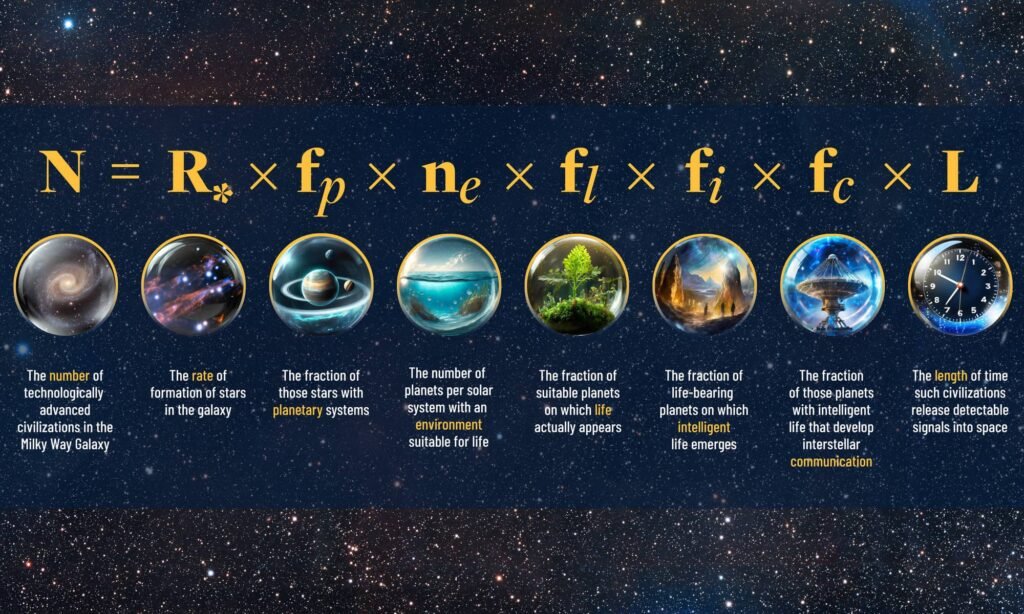Though different in their approaches, the Fermi Paradox and the Drake Equation share a fundamental theme – the search for extraterrestrial intelligence. Both concepts provoke thought about humanity’s place in the cosmos and why, despite promising theories and calculations, we remain isolated. They underscore the mystery of the universe, encouraging ongoing research, exploration, and philosophical inquiry into our understanding of life beyond Earth. Thus, the ongoing conversation about the Fermi Paradox and the Drake Equation remains vital in our quest to comprehend the universe and our potential companions within it.
The Fermi Paradox
The Fermi Paradox addresses the contradiction between the high probability of extraterrestrial life and the lack of evidence for it. Named after physicist Enrico Fermi, it originated from his 1950s question: “If the universe is vast and teeming with life, where is everybody?” Fermi’s insights at Los Alamos National Laboratory led to the paradox, highlighting the absence of verifiable evidence of life despite billions of stars with potentially habitable planets. This paradox sparks scientific discourse and research in astrobiology, cosmology, and SETI. Various hypotheses suggest intelligent life is rare, civilizations self-destruct, or they avoid contact with us. These ideas challenge our understanding of life in the universe and our place in it, emphasizing the mystery of extraterrestrial civilizations.
The Fermi Paradox – Where are all the Aliens? Parts 1 & 2
Potential Explanations
The Fermi Paradox explores why we haven’t detected extraterrestrial civilizations despite the universe’s vastness. One theory, the Great Filter, suggests a significant barrier in evolution prevents intelligent life from developing or communicating. This barrier could be behind us, making intelligent life rare, or ahead, causing civilizations to self-destruct before achieving interstellar communication.
Another hypothesis is that advanced civilizations are too far apart, making communication impractical due to immense distances and time scales. Additionally, advanced civilizations might exist in forms or dimensions humans can’t perceive, making detection difficult. Lastly, the self-destruction of societies through technological progress, like nuclear war or ecological collapse, could prevent civilizations from spreading through the galaxy. These hypotheses help us understand the complexities of the Fermi Paradox and the potential roles of life in the universe.
The Drake Equation
The Drake Equation, developed by Frank Drake in 1961, estimates the number of active, communicative extraterrestrial civilizations in the Milky Way. It was created to guide the first scientific search for extraterrestrial life at the Green Bank Observatory. The equation reflects the 1960s’ fascination with space exploration and astrophysics.
The equation emerged during the Cold War, a time of heightened interest in technological advancements and the potential for discovering extraterrestrial life. It encapsulates variables influencing the development of extraterrestrial civilizations, making it crucial for astrobiological research.
The equation includes factors like the average rate of star formation, the fraction of stars with planetary systems, the number of planets that could support life, the fraction where life develops, the fraction that evolves into intelligent beings, and the longevity of such civilizations. This multidisciplinary approach bridges astronomy, biology, and mathematics, fostering discussions on extraterrestrial intelligence.
Breaking Down the Components
The Drake Equation is a probabilistic formula devised by astronomer Frank Drake in 1961 to estimate the number of active, communicative extraterrestrial civilizations in the Milky Way galaxy. The equation comprises several components, each representing a critical factor in assessing the potential for intelligent life beyond Earth.


- N = the number of civilizations currently transmitting signals, depends on seven factors:
- R* = the yearly formation rate of stars hospitable to planets where life could develop
- fp = the fraction of those stars with planets
- ne = the number of planets per solar system with conditions suitable for life
- fl = the fraction of planets suitable for life on which life actually appears
- fi = the fraction of planets with life on which intelligent life emerges
- fc = the fraction of planets with intelligent life that develops technologies such as radio transmissions that we could detect
- L = the mean length of time that civilizations can communicate
- Here is an example from one astrobiologist:
- R* = 10 (astronomers know roughly 10 stars are made per year)
- fp = 100% (nearly all stars have planets)
- ne = 25% (life can exist in very harsh environments – it would make sense that life could exist on a number of planets)
- fl = 100% (if life can exist, it will)
- fi = 1% (not all life will become intelligent)
- fc = 50% (most intelligent life will be able to invent communication technology such as radio)
- L = 1,000,000 years (intelligent life will exist for a long time)
- 10 x 100% x 25% x 100% x 1% x 50% x 1,000,000 = 12,500 intelligent alien civilizations which may currently exist.
This is just a guess, but shows why some scientists think it will be easy to discover alien life. In summary, each component of the Drake Equation contributes to the overarching inquiry into extraterrestrial life. While astronomers have made strides in estimation, the inherent uncertainties and variabilities in these components underline the complexity of predicting the existence of intelligent life beyond Earth.
Implications on Astrobiology and Society
The Drake Equation profoundly impacts astrobiology, astronomy, and societal views on extraterrestrial life. It uses a multidisciplinary approach to estimate the number of extraterrestrial civilizations in our galaxy by considering factors like star formation rates and the fraction of stars with planets. This helps researchers understand the potential for life beyond Earth, driving astrobiological investigations. Astrobiology relies on the Drake Equation to guide research efforts and measure variables. Discoveries from missions like Kepler and TESS, which find Earth-like planets in habitable zones, are inspired by this equation, suggesting that life-suitable conditions might be more common than previously thought.
The equation also sparks public interest in space exploration and the possibility of extraterrestrial life, leading to increased funding and support for related scientific projects. Philosophically, it prompts discussions about humanity’s place in the universe and our relationship with potential alien civilizations, encouraging broader dialogues about ethics, technology, and our future. In essence, the Drake Equation enhances scientific understanding and connects scientific inquiry with societal curiosity and philosophical thought, shaping academic discourse and cultural narratives about humanity’s venture into the cosmos.
Challenges and Critiques
The Drake Equation, while valuable for framing the search for extraterrestrial life, faces several challenges and critiques. One major concern is the validity of its parameters, such as star formation rates and the percentage of stars with planets, which rely on empirical data that can be difficult to obtain due to observational limitations and the universe’s vastness.
Critics also argue that the equation oversimplifies the complexity of life and intelligence by assuming a linear relationship between factors, ignoring the myriad of environmental, biological, and social conditions that contribute to advanced civilizations. This reductionist approach may lead to an incomplete understanding of life’s prerequisites beyond Earth.
Additionally, the interpretation of the equation’s results varies widely, from millions of potential communicative civilizations to near-zero likelihood. As technologies evolve, our understanding of habitability and life conditions shifts, creating uncertainty in earlier estimates. Thus, the equation may need periodic re-evaluation to align with emerging data, ensuring that it remains relevant and accurate in light of new scientific discoveries and advancements in our search for extraterrestrial life, as well as improved methodologies in assessing potential habitability.
What’s More

My Blog ( 110 )
Dependence (10) Fiction (9) Karma (9) Landmarks (10) Paramount (9) Spectrum (9) Spotlight (9) Take Off (9) Terra Shapes (9) Trepidation (9) Unique (9) Virtue (9)
Amazing Stuff (9) Beyond Known (9) Controversial (9) Digital World (10) Inequities (10) Innovative (9) Metaphysics (9) Orbiting Entities (10) Our Society (10) Outer Space (9) Value Creation (10) Yearnings (10)

My Interests ( 114 )
Site Forum
Curious to dive deeper and ready to share your thoughts on this? Join the conversation and be part of the FORUM@ericroth.org Your online discussion board providing space for engaging exchanges on specific topics and shared interests across this website.











